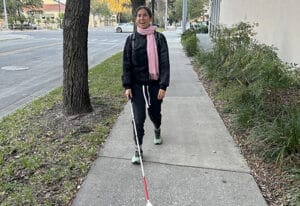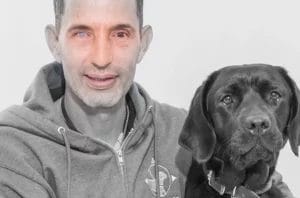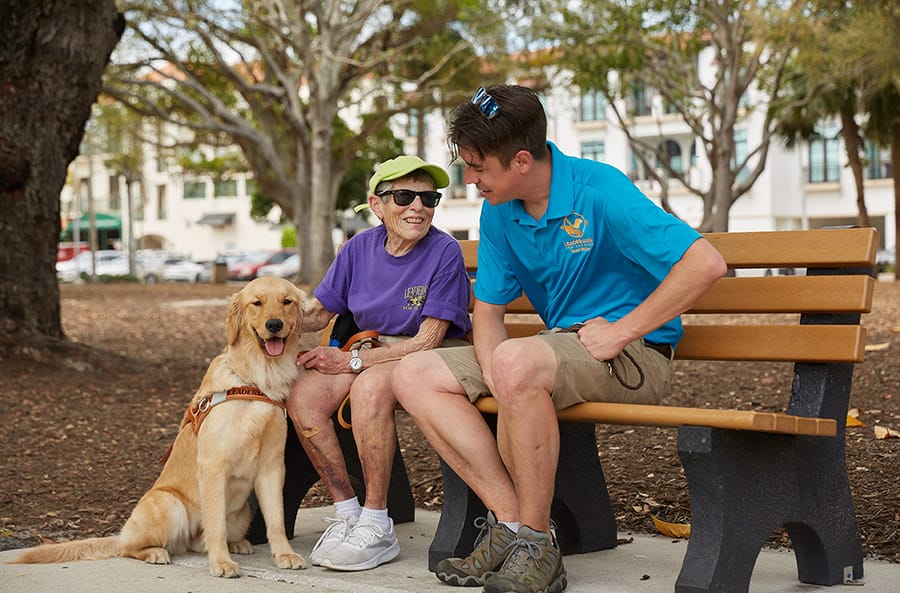
Introduction by Guide Dog Mobility Instructor Ashley Nunnelly.
Hello, readers!
Today I have a different kind of post for you: a collection of special stories.
Sometimes being a guide dog mobility instructor (GDMI) is really hard. During class, you work an average of 60 hours a week (usually more), and it can be emotional, stressful and high pressure. Sometimes you have to break bad news, sometimes you feel like you failed and your heart is broken for a client.
But on the flip side? You see magic. You see independence and confidence blossoming. You make teams and give people their new partner and love. Every GDMI has a story. They have a story that gives them goosebumps that they file away to think about when days get tough. We all have that moment that got us hooked on this job or where we were just incredibly amazed by a person or a dog or it made our little Grinch hearts grow 10 sizes that day.
So, to share some of these special stories with you, I reached out to my teammates! There are instructors here at Leader Dog who have been doing this work for decades. These are their stories.
Keith McGregor ‒ 36 years at Leader Dog
In 1985, we had a client in class named Barbara who was Deaf-Blind. She had enough remaining vision in the right light to read lips but would only understand about 50% to 60% of what we said (which is normal for lip reading). As I got to know her through class, we began talking about Deaf-Blindness. Barbara said, “You should learn sign language because there are a lot of people who are Deaf-Blind and want a guide dog but no guide dog schools will train them.” I thought to myself, after doing this work for several years, you are the only client who is Deaf-Blind that I’ve met. How many other people with dual loss could there be? Toward the end of class, she bought me a book about learning American Sign Language (ASL) and suggested I attend a conference for people who are Deaf-Blind. I proposed this to Leader Dog and they supported me in attending this conference.

I was overwhelmed to say the least. I met hundreds of people who had dual loss and many I spoke with (through interpreters) said they were interested in getting a guide dog. After I returned from this conference, I wrote up a proposal to ask for support to go learn ASL. Leader Dog accepted the proposal and the Deaf-Blind Guide Dog Training program was born. If not for Barb being willing to come here for guide dog training when no one could communicate clearly with her, and for Leader Dog being open to working with clients who wouldn’t be accepted at other organizations, this program would never have been developed.
The other story is about a client who lived and worked in Washington D.C. and came to Leader Dog with quite a bit of remaining vision and dual hearing aids (she had been diagnosed with retinitis pigmentosa and Usher syndrome type II). After a few days of being here, she told me she didn’t belong here because she wasn’t “blind.” I asked her to give me two weeks to show her how a Leader Dog could assist her, even with remaining vision. She got a yellow Labrador named Beau. She ended up staying and graduating with Beau, and he became her life. She showed him her route around D.C. including the Metro system, traveled the world, even became the first person allowed to take a guide dog on the Senate floor. As the years went by, she lost all of her vision and became very reliant on her dog to travel around D.C. Years later, Beau retired. Since then she has come back for three more Leader Dogs and now wouldn’t be without one. To think she almost decided to leave the program because she felt she had too much vision.
(Ashley here: Keith is credited with being a pioneer of training guide dogs for Deaf-Blind clients. He is being humble—there have been hundreds of clients served through Keith’s innovation and hard work! Thank you, Keith!)
Meredith Bryde ‒ 5 years at Leader Dog
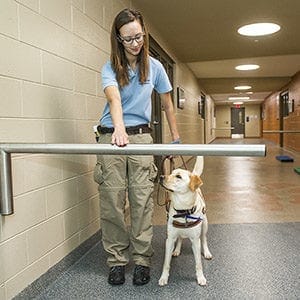
I was working with a client from Spain who was a new guide dog user. He was very active in his personal life—skiing, golfing, hiking—he did not let anything hold him back from the activities he liked to do. When he met his guide dog the first time, they had a tearful, lovely first greeting. I gave him about half an hour and then took his dog out on their first walk. When we left the building and went on the practice course, he whispered, “This is what it is like to just walk?” Even after all his activities, he was so floored at the feeling of just walking without a cane. He immediately started crying and bent down to hug his new dog. They have been doing great ever since.
Heidi Vollrath ‒ 4 years at Leader Dog
Sometimes it is the little things that happen in class that keep you going. Every class, we teach our clients with a method called “back chaining,” which is a technique that helps a dog learn to return to objects in an environment after moving away from them. Typically, this is used for specific doors and chairs but can really be used with anything. After giving the lesson each class, I like to give my clients a little “homework” assignment of patterning (using back chaining to teach their dog to consistently find a specific object) their dog to a new item in the residence area here at Leader Dog. Clients will usually pattern them to a chair in the piano lounge or a specific door.
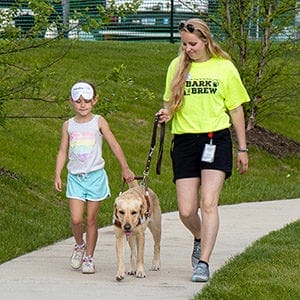
One class after a long day I was sitting in the instructors’ office checking email and discussing the plans for the next day. The wall of the instructors’ office is windows so that GDMIs can keep an eye out to assist clients when needed. On this particular day, one of my clients was going back and forth just on the other side of the windows, working his golden retriever in harness. With each pass the team looked more confident. The golden retriever’s tail wagged faster and he picked up his pace, the client’s grin got larger each time they passed the windows. One of my coworkers walked in and asked me what this particular client was doing. I responded that I wasn’t sure but they looked great working together and then went on with the email checking.
The next morning at breakfast, the client with his golden retriever lying faithfully beside him told me with the biggest grin on his face how he patterned his dog to find the ice cream vending machine the night before. A light bulb went off in my head! That’s what they had been doing! He went on to tell me how excited he was to pattern his dog to his P.O. box and many other things when he got home. It was amazing to see how he was able to creatively apply our lesson to a destination (the ice cream machine) that was important to him and how that would translate to his everyday life. Watching my clients discover the small, unexpected ways their dog is going to help them in their day-to-day lives is one of the pleasures of my job as a GDMI.
Phil Griffin ‒ 30 years at Leader Dog

My story does not include a client but rather a graduate return dog I was tasked with evaluating upon its return. In my 30 years of training dogs to be guide dogs, one scenario that has always impressed me was this work evaluation. The dog and I (I honestly do not remember the name—this was the mid ‘90s) were working on Main Street in Rochester, traveling south from 5th to 4th streets. At that time there was a sports shop know as the Varsity Shop on the west side of Main, about mid-block. The business was in the process of closing, and a moving semi truck was parked curbside in front of the business. The movers had a loading ramp extended from the trailer into the actual front door of the store. There was no getting around this hazard while remaining on the sidewalk. Did I mention that the loading ramp was located at the front of the trailer and we were approaching from the back? The trailer was probably 45 feet long and the door maybe 10 feet from the front of the trailer.
Realizing the dog had no way to get around, we approached the loading ramp. I was casually observing the dog, well aware that I was probably going to have to provide a level of support and direction as there was no clear way to avoid or work this as an obstacle without turning back or avoiding it all together. As we approached the ramp, I could tell that the dog was sizing up the situation. I fully expected an attempt to duck under the ramp and from there, I would need to stop the mistake and direct the dog. Instead, we stopped at the ramp, similar to an overhead obstacle. I praised and gave the “forward” command. Expecting the worst, I hung on and waited to see what would happen. What do you think the dog did next? Wouldn’t you know it, this dog turned me a complete 180 degrees and worked me to the back of the semi-trailer where he turned, faced the street and stopped at the curb like a good boy. Not wanting to believe it and thinking to myself, “Is this dog really going to do this?” I again gave the “forward” command. The dog stepped off the sidewalk onto the street, worked to the side of the truck where he turned and paralleled the entire truck on the street side until he cleared the front of the truck, turned and took me back to the curb and sidewalk. Mind you, all I did was ask the dog to go forward. That’s some good problem solving!
Kate Roberts ‒ 8 years at Leader Dog
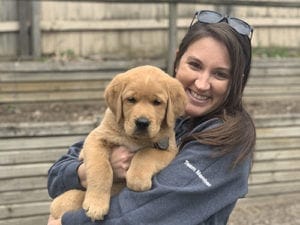
I have worked with several groups of clients from Central and South America. After working with a few of these groups of clients, I went on a couple of trips (Costa Rica and Peru). It wasn’t until I was in the environment that I truly appreciated what our dogs adapt to with the support of their handlers. The huge grates over gutters, large gutter drops-offs (many times over a foot deep), broken sidewalks, crowded streets and buses, different animal distractions—the ability of our dogs to adapt to all of these changes is astonishing. There is only so much we can do as puppy raisers and instructors to prepare them for the life they may have as a Leader Dog. The rest is up to these special dogs and the clients. This was really driven home when I went to these other areas of the world.
Ashley Nunnelly ‒ 5 years at Leader Dog
I piloted a new training technique with a small group of clients in a recent class. Essentially, it is a cleaner and more effective method to teach clients to teach their dogs to “target” different destinations. This is useful for when they are home (with no instructor around) and they want to teach their dog to accurately find their mailbox, or their door, or the restroom in their workplace, etc. And to make sure that the dog does it on cue.
Well, I had done a few sessions of instruction with this new method and one of the client’s dogs was very successful at “find the piano.” He challenged, “Well, [the dog] is only doing this because we just fed him a lot there.”
So, I said with confidence, “You’re right. Now tell him ‘find the coffee.’” While we had worked on “find the coffee” the day before, the dog had never found the coffee from as far away as he was at that moment. Honestly, I was taking a risk with my bravado there.
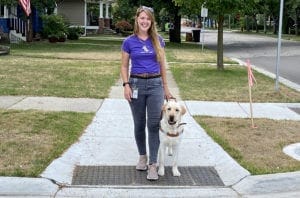
As soon as he heard the cue, this angel of a dog walked out of the room, around the corner, into a different room, and booped his nose right at the precise spot on the coffee counter where we had been working the day before.
“Wooooooow!” the client said.
I said, “Okay, now say ‘find the piano.’” Again, it was quite the risk. We had not worked on targeting this brand new object from that distance.
The dog confidently walked through the door, around the corner and back to the piano bench.
“Oh my gosh!” the client said with joy.
After the session, the client came up to me and said, “So it’s because of you that we’re allowed to do this? Can I give you a hug? Thank you so much!”
Best moment of my whole career so far. Every day I strive to give people that level of empowerment. That client doesn’t need me anymore! THAT’S what Leader Dog does.

